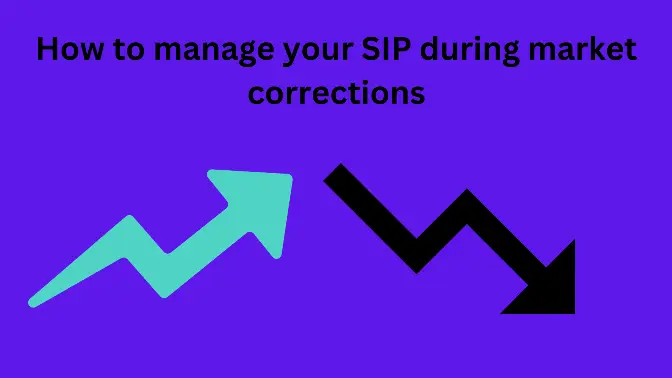Investing in systematic investment plans (SIPs) is a popular strategy for long-term wealth creation.
However, managing your investments during market corrections can be challenging, even for experienced investors.
Market corrections, which involve a decline of 10% or more from the recent high, are a natural part of the market cycle but can cause anxiety and uncertainty.
In this comprehensive guide, we will discuss strategies for managing your SIP investments during market corrections to maintain your financial goals and ensure a steady investment journey.

Understanding Market Corrections
Before we delve into strategies for managing your SIPs during market corrections, it’s essential to understand what market corrections are and their impact on your investments.
Market Corrections vs. Bear Markets
Market corrections are temporary declines in the market, usually lasting a few weeks to a few months.
They differ from bear markets, which are more prolonged periods of decline, typically lasting at least 18 months.
While market corrections can be unnerving, they often present opportunities for long-term investors to invest in quality assets at lower prices.
The Role of SIPs in Market Corrections
One of the key benefits of investing through SIPs is the ability to take advantage of rupee cost averaging.
During market corrections, this can work in your favor, as you will be able to accumulate more units of your chosen mutual fund or investment option at lower prices.
Over time, as the market recovers, these additional units can contribute to higher returns, making market corrections less daunting for SIP investors.
Strategies for Managing SIPs During Market Corrections
To effectively manage your SIP investments during market corrections, consider the following strategies:
Stay Calm and Maintain Perspective
When faced with a market correction, it’s crucial to remain calm and maintain a long-term perspective.
Corrections are a natural part of the market cycle, and reacting impulsively can often lead to poor investment decisions.
By keeping your long-term financial goals in mind and focusing on your overall investment strategy, you can navigate market corrections with greater confidence.
Avoid Stopping or Redeeming Your SIPs
During market corrections, it can be tempting to stop or redeem your SIP investments to minimize losses.
However, doing so can be counterproductive, as you may miss out on the benefits of rupee cost averaging and the potential for higher returns when the market recovers.
Instead, consider maintaining your regular SIP investments to capitalize on lower asset prices and accumulate more units.
Reassess Your Risk Tolerance
Market corrections can serve as a reminder to reassess your risk tolerance and ensure that your investment portfolio is aligned with your financial goals and risk appetite.
If you find that the market correction has caused you significant stress, it may be an indication that you need to adjust your portfolio to better suit your risk tolerance.
This may involve rebalancing your asset allocation or choosing more conservative investment options.
Rebalance Your Portfolio
Market corrections can cause shifts in your portfolio’s asset allocation, potentially exposing you to more risk than you are comfortable with.
Rebalancing your portfolio involves adjusting your asset allocation back to your desired level by selling over-weighted assets and buying under-weighted assets.
This can help you maintain an appropriate risk profile and ensure that your investments remain in line with your financial goals.
Evaluate the Fundamentals
During market corrections, it’s essential to evaluate the fundamentals of your investments to determine if any changes are warranted.
Focus on the quality of the underlying assets, the fund manager’s track record, and the overall performance of your chosen mutual funds or investment options.
If your investments remain fundamentally sound, there may be no need for drastic changes during a market correction.
Consider Increasing Your SIP Amount
If you have additional funds available and a higher risk tolerance,
you may consider increasing your SIP investment amount during market corrections.
This strategy allows you to accumulate more units at lower prices, potentially enhancing your long-term returns.
However, it’s crucial to ensure that you can comfortably afford the increased investment amount and maintain it consistently over time.
Diversify Your Investments
Diversification is a key principle of successful investing and becomes even more critical during market corrections.
By spreading your investments across various asset classes, sectors, and geographical regions, you can reduce your overall risk and protect your portfolio from the impact of market fluctuations.
Ensuring your SIP investments are well-diversified can help you navigate market corrections more effectively and maintain your long-term financial goals.
Consult a Financial Advisor
If you’re unsure about how to manage your SIP investments during market corrections, consulting a financial advisor can be beneficial.
A professional advisor can help you evaluate your portfolio, assess your risk tolerance, and make recommendations based on your specific financial situation and goals.
Having expert guidance can provide reassurance and help you make informed decisions during uncertain times.
Preparing for Future Market Corrections
While it’s impossible to predict when market corrections will occur, you can take proactive steps to prepare your SIP investments for future market downturns:
Establish an Emergency Fund
An emergency fund acts as a financial safety net, providing a source of funds for unexpected expenses or income disruptions.
By maintaining an emergency fund, you can avoid the need to redeem your SIP investments during market corrections, allowing you to remain invested and benefit from potential market recoveries.
Regularly Review Your Investment Strategy
Periodically reviewing your investment strategy ensures that it remains aligned with your financial goals, risk tolerance, and market conditions.
By making adjustments as needed, you can minimize the impact of market corrections on your SIP investments and maintain a steady investment journey.
Keep Learning and Stay Informed
Educating yourself about market trends, investment strategies, and financial planning can help you make better-informed decisions and manage your SIP investments more effectively during market corrections.
Stay updated on financial news, attend webinars, or read books and articles to enhance your knowledge and understanding of the investment landscape.







